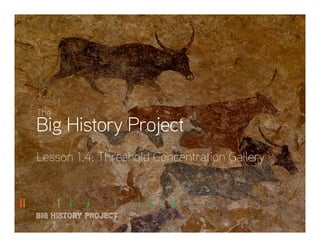
2.X Threshold Concentration
- 1. The Big History Project Lesson 1.4: Threshold Concentration Gallery
- 2. 2 RULES OF THE GAME BIG HISTORY PROJECT / THRESHOLD CONCENTRATION Preparation • Print the slides from Threshold Concentration Gallery PowerPoint and make them into cards for the game concentration (you can print multiple slides on one piece of paper). • Cut out the threshold images and the corresponding threshold cards. Be sure you have enough to have multiple groups of players. • To save time, you can have the cards printed in advance and you can have students do the cutting in their groups. Directions: This is simply a game of concentration, which many students probably played when they were younger. Quickly go over the rules of the basic game with the students: • Shuffle the cards and turn them face down in a grid like pattern. The goal is to remember where the cards are and to match each threshold image with its corresponding threshold card. • For each turn, a student picks up two cards. If the cards match they keep them. If not, they put them back exactly where they were before and the next student goes. All students should see the cards and where they were placed each turn. • The game is over when all pairs have been made. The student with the most pairs wins. In addition to the basic rules, you’re going to add two additional rules to make it harder. • Rule 1: If you match a threshold pair, you have to identify an object nearby and relate it to the threshold in order to keep the pair. For example, if the matching pair is Threshold 3, new chemical elements, you might point to silver earrings that someone is wearing and identify silver as an example of an element. • Rule 2: If you turn over a threshold image first, you must list either the ingredients or the Goldilocks Conditions associated with that threshold. If a player can’t comply with the two rules, they don’t keep the pair. TEACHER MATERIALS
- 3. 3 RULES OF THE GAME BIG HISTORY PROJECT / THRESHOLD CONCENTRATION Directions: This is just a Big History spin on concentration, a game you probably played when you were younger. Just in case you don’t remember, here’s how you play: • Shuffle the cards and turn them face down in a grid-like pattern. The goal is to remember where the cards are and to match each threshold image with its corresponding threshold card. • For each turn, one person in your group picks up two cards. If the cards match, that person keeps them. If not, they put the cards back exactly where they were before and the next student goes. All students should see the cards that were picked and where they were placed each turn. • The game is over when all pairs have been made. The student with the most pairs wins. In addition to the basic rules, you’re going to add two additional rules to make it harder. • Rule 1: If you match a threshold pair, you have to identify an object nearby and relate it to the threshold in order to keep the pair. For example, if the matching pair is Threshold 3, new chemical elements, you might point to silver earrings that someone is wearing and identify silver as an example of an element. • Rule 2: If you turn over a threshold image first, you must list either the ingredients or the Goldilocks Conditions associated with that threshold. If a player can’t comply with the two rules, they don’t keep the pair. STUDENT MATERIALS
